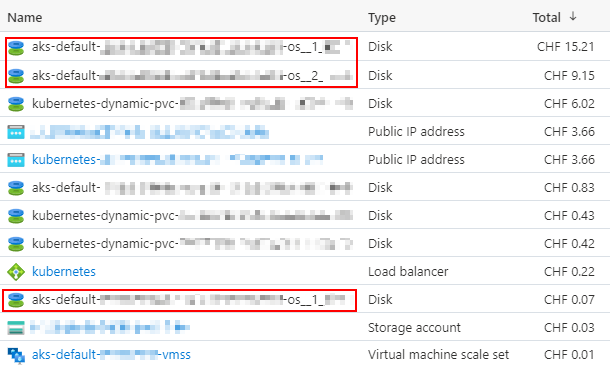Reduce Storage Costs when Deploying Azure Kubernetes Service Clusters with Terraform
I use the Azure Kubernetes Service (AKS) to host a few services, like Synapse,
Remark42, and Plausible Analytics. As of yet, none of these services require
much computing power, so I chose a small VM size for the AKS node:
Standard_B2ms. I recently analyzed my Azure costs and found out that I could
have saved more than a hundred bucks in the past months if I had been more
diligent.
What Storage Does AKS Use?
Besides the underlying storage of Persistent Volumes Kubernetes deployments use, there’s also the node itself requiring an OS disk. For OS disks, two types exist: managed and ephemeral. The Microsoft docs note the following on ephemeral OS disks:
By default, Azure automatically replicates the operating system disk for an virtual machine to Azure storage to avoid data loss should the VM need to be relocated to another host. However, since containers aren’t designed to have local state persisted, this behavior offers limited value while providing some drawbacks, including slower node provisioning and higher read/write latency.
By contrast, ephemeral OS disks are stored only on the host machine, just like a temporary disk. This provides lower read/write latency, along with faster node scaling and cluster upgrades.
Like the temporary disk, an ephemeral OS disk is included in the price of the virtual machine, so you incur no additional storage costs.
I created my cluster in 2021, and ephemeral OS disks have been generally available since November 2020 and B-series VMs support ephemeral OS disks. However, the cost analysis in the Azure Portal shows that I’m incurring storage costs for my cluster’s managed OS disks. The following screenshot shows that I paid CHF 24.43 in October 2021.

I pay CHF 33.50 per month for the Standard_B2ms VM instance, which the
screenshot doesn’t correctly display. To save around 70% compared to
pay-as-you-go prices, I use
Azure Reserved Virtual Machine Instances,
which Microsoft bills separately. So why am I paying for a managed OS disk
that almost doubles the operating cost of my AKS cluster? Well, because I made a
mistake.
Using Terraform to Deploy AKS
I use Terraform to manage my AKS cluster.
The azurerm_kubernetes_cluster Terraform resource features the
os_disk_type
option:
(Optional) The type of disk which should be used for the Operating System. Possible values are
EphemeralandManaged. Defaults toManaged. Changing this forces a new resource to be created.
Here it is! I didn’t explicitly set it to Ephemeral when I initially
configured my cluster over six months ago. An expensive mistake!
Update on Ephemeral OS Disk Support for B-series VMs
As someone correctly pointed out in the comments, B-series VMs don’t support ephemeral OS disks. My tests with the Azure CLI and Terraform confirm his findings. The information from the official Microsoft documentation on this is inconsistent. Someone on GitHub mentioned a query from the Microsoft docs to determine VM types supporting ephemeral OS disks. Interestingly, the query result suggests B-series VMs support ephemeral OS storage.
$vmSizes = Get-AzComputeResourceSku | where { $_.ResourceType -eq 'virtualMachines' -and $_.Locations.Contains('CentralUSEUAP') }
foreach ($vmSize in $vmSizes) {
foreach ($capability in $vmSize.capabilities) {
if ($capability.Name -eq 'EphemeralOSDiskSupported' -and $capability.Value -eq 'true') {
$vmSize
}
}
}
Due to these limitations with B-series VMs, right now, it’s more efficient to run general-purpose D-series VMs instead.
